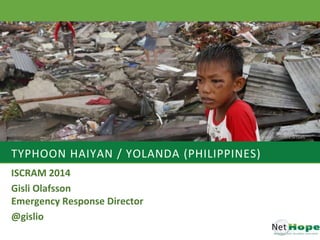
Haiyan Response - ISCRAM Panel Presentation
- 1. TYPHOON HAIYAN / YOLANDA (PHILIPPINES) ISCRAM 2014 Gisli Olafsson Emergency Response Director @gislio
- 2. NETHOPEEMERGENCYRESPONSE Typhoon Haiyan/Yoldanda – 8 November 2013
- 3. NETHOPEEMERGENCYRESPONSE NetHope Member NGO Office Locations
- 4. NETHOPEEMERGENCYRESPONSE NetHope Members Active Member Activities Member Activities ActionAid BY International Federation of Red Cross/ Red Crescent (IFRC) BSQ(hY AmeriCares h International Medical Corps (IMC) h CARE BS Islamic Relief ( Catholic Relief Services BS MercyCorps BS(hY ChildFund International Y Oxfam International BShY Christian Aid h Plan International BSY Concern Worldwide ( Relief International h Direct Relief h Save the Children ShY Habitat for Humanity B SOS Children’s Villages Y Heifer International Y World Vision BY B shelter S water Q supplies ( ICT assessments h medical Y food / families / women & children
- 5. NETHOPEEMERGENCYRESPONSE NetHope’s Response - 3 VSATs installed in partnership with BT - 6 additional VSATs installed in partnerships with NetHope members - 105 satellite phones handed out - 14 BGANs handed out - 300 laptops handed out - 200 VOIP headsets handed out - 50 video cameras handed out - ICT assessments performed in East Samar, North Cebu, and Panay Island - ETC cluster and NetHope community working as one
- 7. COORDINATEDICTRESPONSE Emergency Telecom Cluster Coordination
- 8. COORDINATEDICTRESPONSE ICT Assessment Methodology • Initial Assessment (First days) • Based on secondary data sources • Mobile operator data • Social media reports • Media reports • Response organization information • Used to determine the initial scope of the ICT infrastructure damage • Rapid Field Assessments (First 1-2 weeks) • Field trips to affected areas • Visual surveying of affected damage to infrastructure • Interviewing of key stakeholders • Connectivity assessments • Needs of response organizations, affected population captured.
- 9. COORDINATEDICTRESPONSE ICT Assessments – things to consider • Consider leveraging more crowd-sourced information • Collaborate with the infrastructure operators • Use network infrastructure data • Don’t forget power, fiber, etc.
- 21. INFORMATIONMANAGEMENT Good – Bad - Ugly • More information being shared amongst organizations • More coordinated use of digital volunteers • More joint assessments within humanitarian community • Lack of data standards slowing down use of shared data • Extensive data processing needed to use shared data • Lot of duplication of efforts • Lack of coordination with government response • Lack of involvement with local community • Lack of attention to areas outside of CNN focus area
- 22. INFORMATIONMANAGEMENT Way Forward • We need data standards for core emergency response data • We need easy ways of sharing our data in machine readable format • We need more coordinated information management efforts • We need to work closely with affected governments • We need to build information management capacity in disaster prone developing countries • We need to focus on entire affected area, not just where media is • We need to involve the affected community in the information management effort • We need new ways of funding innovation and research in the humanitarian space.
